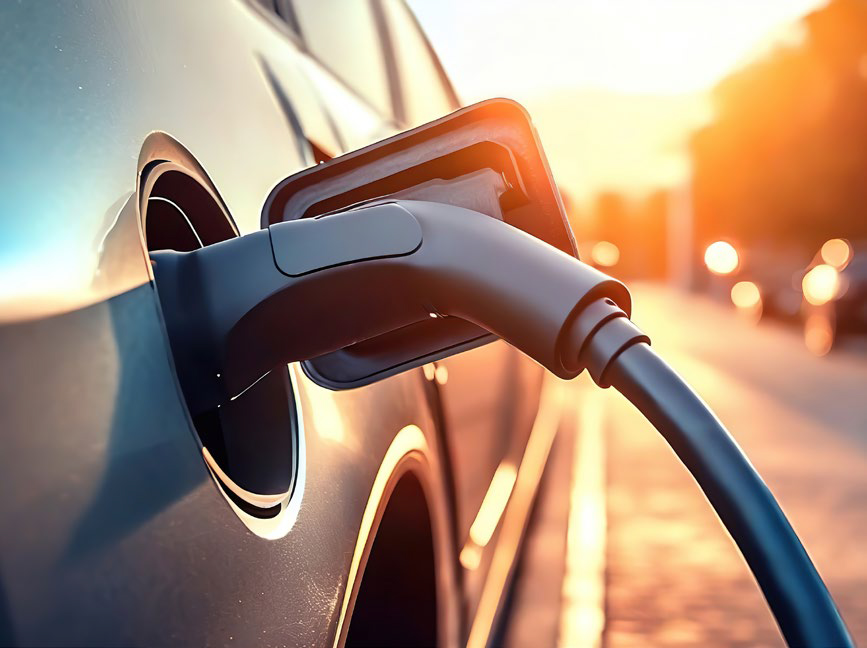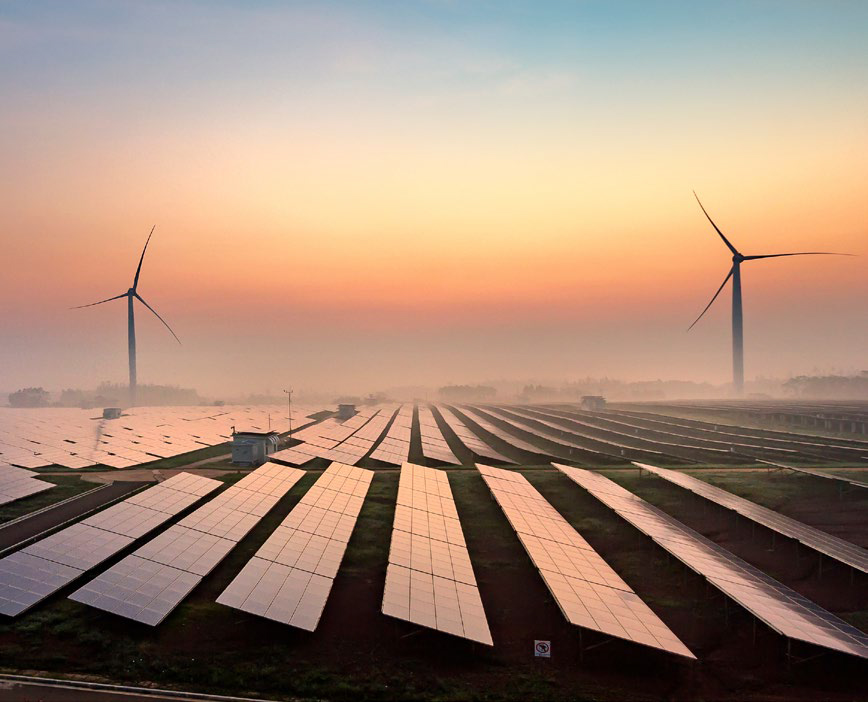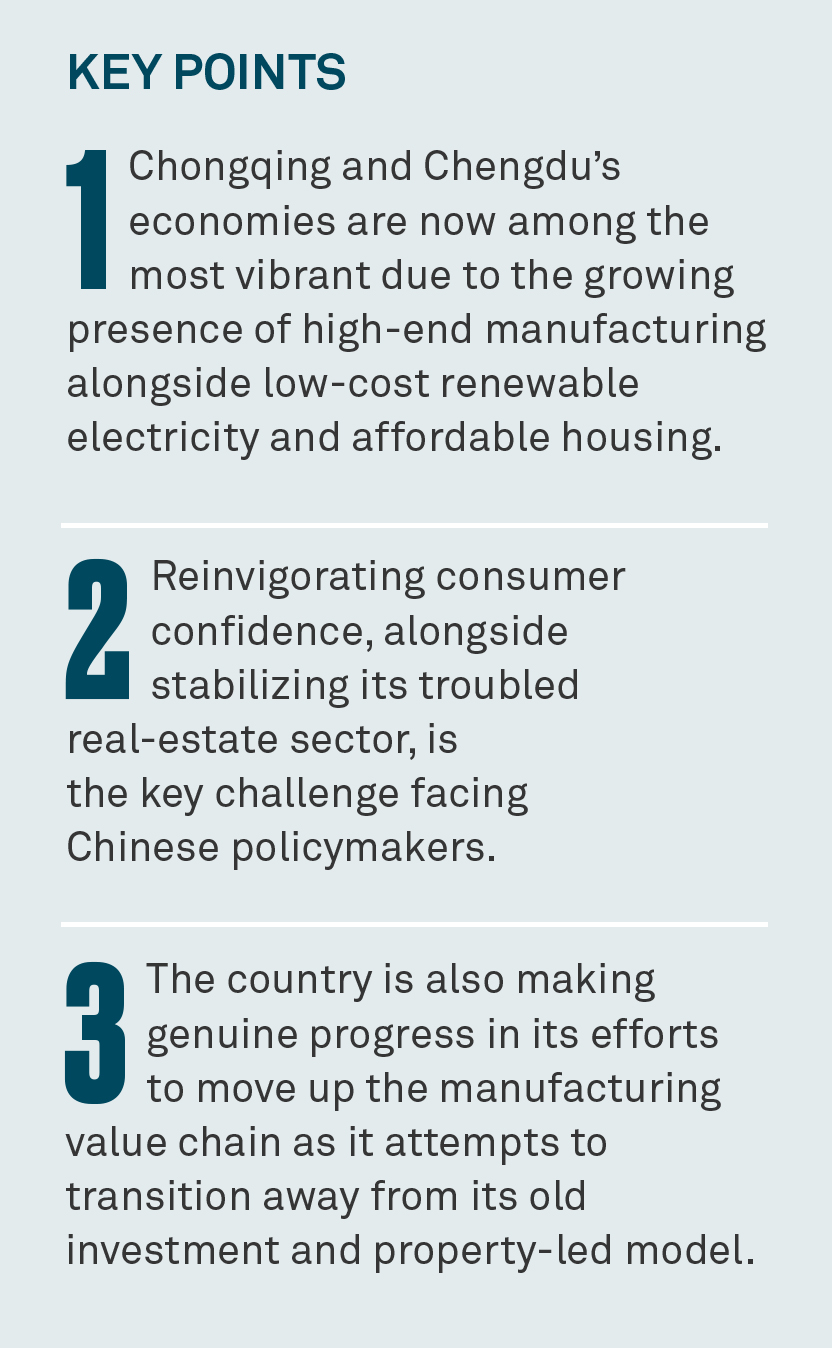December 2024
China’s days of turbocharged growth may be a thing of the past, but the country’s economic evolution has put it in the vanguard of some powerful long-term growth trends. A research trip to two of China’s fastest growing cities revealed more.
Chongqing and Chengdu
Much has changed in China in the last decade. China’s economy is stalling, the country is proving a much trickier market for Western brands, and geopolitical risk looms large.
However, a trip to two of the fastest growing cities in China, Chongqing and Chengdu, served as a healthy reminder about making generalizations about a country as complex as China. Though Chongqing and Chengdu are not first-tier cities,1 they are dynamic and important cities for China’s economy. These two cities are the focal points of the Chengdu-Chongqing Economic Circle, the first national-level economic development zone in the west of the country and their economies are now among the most vibrant due to the growing presence of high-end manufacturing alongside low-cost renewable electricity and affordable housing.
Across a series of meetings, we spoke with companies from a diverse range of sectors.
Three areas were of particular interest:
- China’s booming electric vehicle (EV) industry and the impact on Western manufacturers
- The implications of China’s huge investments in decarbonization
- Baijiu, China’s iconic national drink, and the read-through to the Chinese consumer

An Electric Vehicle Superpower
Scroll back to 2021 and China’s auto manufacturers lagged well behind the traditional exporting powerhouses of Germany, Japan and South Korea. Today, the country is the world’s leading exporter of passenger cars. How China managed this impressive feat is in large part due to its expertise in electric vehicles (EVs).
Contrary to the popular narrative of China being a copier of Western innovation, the country’s EV players are among the most innovative auto companies globally. State support has been vital to their development, but these are no mere subsidy junkies. Many are efficient, leading-edge businesses. Not only are their vehicles considerably cheaper than those of Western peers, but they can develop and release new models much more quickly. Little wonder that they have come to dominate the global EV market. Even Elon Musk, once dismissive of Tesla’s Chinese rivals, has grudgingly acknowledged that its auto manufacturers are “the most competitive car companies in the world.”
We believe that all of this signals tough times ahead for the Western marques operating in China today. The likes of BMW, Mercedes, Audi and Tesla (which recently exported its millionth vehicle from its Chinese manufacturing facility) might still dominate the premium end of the market, but the domestic competition is gaining on them with better technology, longer battery ranges, and lower price points. China’s EV market is becoming increasingly competitive for Western brands, many of which have staked a great deal on success in China.
It’s not all good news for China’s EV players, however. The imposition of trade tariffs by the US and EU has complicated the export route map, an unhelpful development at a time when many companies are looking to overseas expansion as an offset to intense domestic competition.
Speaking with one of the major Chongqing-based auto players, it was clear that its export focus for now is Southeast Asia, a market with enormous potential and fewer geopolitical complications. The share of Chinese-made autos in the region is projected to grow from 13% in 2023 to 27% in 2030, with EVs accounting for 60–70% of vehicles sold.2

Green Silicon Valley
Rich in natural resources and access to clean energy, the Chengdu-Chongqing Economic Circle is central to China’s ambitions of achieving energy independence. In today’s uncertain geopolitical environment, Beijing has identified a reliance on imported energy as a strategic vulnerability. This desire for energy security, more than environmental considerations, has prompted huge investment in low-carbon technologies in recent years.
While still heavily dependent on imported fossil fuels, China is now the world leader in solar and wind power, with installed capacity massively outstripping other major economies. It has also established dominant positions in renewable supply chains. In solar, it is estimated to have around 80% of the world’s polysilicon, wafer, cell, and module manufacturing capacity.3 Meanwhile, four of its wind turbine manufacturers are in the world’s top five.
The Chengdu-Chongqing Economic Circle is home to China’s “Green Silicon Valley,” a vast ecosystem of companies involved in the solar power supply chain. GCL Technology, for example, manufactures polysilicon for use in photovoltaic solar panels. An unremarkable business until quite recently, the acquisition of SunEdison’s solar business enabled GCL to commercialize a polysilicon manufacturing process called FBR. Cheaper, cleaner and reputedly producing polysilicon of a higher quality than the prevailing process, FBR has transformed the company’s prospects.
Like other players in the solar supply chain, however, GCL has endured a hugely volatile few years. An explosive upswing in demand when China formally embarked on the path to decarbonization and energy independence was inevitably followed by a period of over-supply and plummeting prices across the entire supply chain. Now, with many companies struggling to operate well below their cost of production, supply is starting to exit the industry. Once that process has played out, the long-term outlook for those companies left standing should be extremely bright.

Welcome to Liquor City
Although its exact origins are unknown, baijiu, China’s national drink, is thought to date back several thousand years. A colorless spirit typically made from a variety of raw materials, including sorghum, rice, corn, barley and wheat, the drink is an inseparable part of Chinese etiquette and a must-have at events and celebrations. Mao Zedong presented baijiu as a gift to Joseph Stalin when the two met in 1950 and it was served at the welcoming banquet for Richard Nixon’s epochal trip to China in 1972. In 2023, global sales of baijiu were estimated at US$167 billion.4
A couple of hours outside Chongqing is Luzhou, also known as “Liquor City” and home to some of China’s largest and most storied baijiu producers. One of these, Luzhou Laojiao, operates 400-year-old fermentation pits, in which sorghum grain is fermented over a period of months. Over time, the unique microbiome of each pit develops ever-more complexity. We believe this unparalleled maturity creates a strong brand narrative and acts as a major barrier to entry for Luzhou Laojiao’s ultra-premium baijiu.
Also based in Luzhou is Wuliangye Yibin, China’s second largest baijiu producer and the second most valuable spirits brand globally (its fierce competitor Moutai is first, with Luzhou Laojiao third). For comparison, Wuliangye’s brand was valued at US$26 billion, more than four times that of the nearest Western brand, Hennessy. Wuliangye plays at the higher end of the baijiu price curve and so is well positioned, in our view, to benefit from the “premiumization” trend of Chinese drinkers trading up in quality. It recently released a hyper-premium product costing over 2,000RMB per bottle (around US$280), tapping into the ever-increasing demand from the richest in Chinese society.
However, both Wuliangye and Luzhou Laojiao spoke of headwinds from a slowdown in consumer spending. Big occasions for high-end baijiu consumption, such as banquets and business celebrations, are happening less frequently, and the propensity for gift giving is also subdued. While this has been offset by the structural growth of the market and the trend towards premiumization, it may take time before growth accelerates to the eye-catching levels of the baijiu boom of a few years ago.
Opening the Chinese Wallet
Reinvigorating consumer confidence, alongside stabilizing its troubled real-estate sector, is the key challenge facing Chinese policymakers. The downbeat messaging of the baijiu houses in Luzhou was echoed by companies we met with in Hong Kong. Companies from the beauty, apparel and luxury sectors spoke of a challenging environment in which consumers are choosing to save rather than spend. The one silver lining appears to be that this caution is sentiment driven rather than due to falling incomes or genuine economic hardship. In short, the Chinese consumer is worried.
The million-dollar question now is whether Beijing’s recently announced package of monetary stimulus and still-vague statements concerning supportive fiscal measures will be enough to resuscitate the “animal spirits” of the Chinese consumer and stabilize the country’s troubled real estate sector, which has been a key drag on consumer confidence and industrial activity. Can Beijing pull off its own
“Draghi moment,” a “whatever it takes” intervention that puts a floor under property prices and establishes mechanisms for clearing inventory?
In the immediate aftermath of the announcement, the market signaled its approval, sending Chinese stocks on a rally in the closing days of September. The euphoria did not last long, however, and investors have since been more circumspect. The onus is now on policymakers to follow through on their initial communications with concrete details of substantial and well-crafted fiscal support.
Final Thoughts
Traveling around China can serve as a useful antidote to the negative media coverage of the country we are often exposed to in the West. Contrary to some of the more doom-laden headlines, there is still a huge amount of economic dynamism and innovation on display. The country is also making genuine progress in its efforts to move up the manufacturing value chain as it attempts to transition away from its old investment and property-led model.
That said, there are clearly issues that the country needs to address. There is clear evidence of real estate overbuild and industrial over-capacity, as well as prevalent signs of economic pain outside the big cities. As mentioned above, the authorities have work to do to boost the average consumer’s sense of financial security.
What does all this mean for investors? We don’t subscribe to the view that the China “story” is over. True, the days of breakneck economic growth may be a thing of the past, but as the country positions itself at the forefront of emerging trends, such as renewable energy and electric vehicles, it is becoming an ever more important component of the global economy. China, in our view, will continue to offer exciting opportunities for the right company, with the right strategy and the right product.
1 Beijing, Shanghai, Guangzhou and Shenzhen. These cities are known for being important political, cultural, industrial and financial centers in China. The classification is based on a variety of parameters such as population, size, GDP, and administrative hierarchy.
2 BBVA Research, China EV sector: forging ahead amid intensifying headwinds, June 2024.
3 Wood Mackenzie, “China dominance on global solar supply chain,” November 2023.
4 Forbes, “What You Should Know About Baiju, The ‘World’s Most Popular Spirit,’” August 2024.
Animal spirits is a term coined by British economist John Maynard Keynes to describe how people arrive at financial decisions, including buying and selling securities, in times of economic stress or uncertainty.
All investments involve risk, including the possible loss of principal. Certain investments involve greater or unique risks that should be considered along with the objectives, fees, and expenses before investing.
Company information is mentioned only for informational purposes and should not be construed as investment or any other advice. The holdings listed should not be considered recommendations to buy or sell a security.
BNY Investments is one of the world’s leading investment management organizations, encompassing BNY’s affiliated investment management firms and global distribution companies. BNY is the corporate brand of The Bank of New York Mellon Corporation and may be used to reference the corporation as a whole and/or its various subsidiaries generally.
This material has been provided for informational purposes only and should not be construed as investment advice or a recommendation of any particular investment product, strategy, investment manager or account arrangement, and should not serve as a primary basis for investment decisions.
Prospective investors should consult a legal, tax or financial professional in order to determine whether any investment product, strategy or service is appropriate for their particular circumstances. Views expressed are those of the author stated and do not reflect views of other managers or the firm overall. Views are current as of the date of this publication and subject to change.
The information is based on current market conditions, which will fluctuate and may be superseded by subsequent market events or for other reasons. References to specific securities, asset classes and financial markets are for illustrative purposes only and are not intended to be and should not be interpreted as recommendations. Information contained herein has been obtained from sources believed to be reliable, but not guaranteed. No part of this material may be reproduced in any form, or referred to in any other publication, without express written permission.
Walter Scott & Partners Limited (“Walter Scott”) is an investment management firm authorized and regulated in the United Kingdom by the Financial Conduct Authority in the conduct of investment business. Walter Scott is a subsidiary of The Bank of New York Mellon Corporation.
© 2024 BNY Mellon Securities Corporation, distributor, 240 Greenwich Street, 9th Floor, New York, NY 10286.
MARK-616774-2024-10-17
